The washing machine hopper is leaking
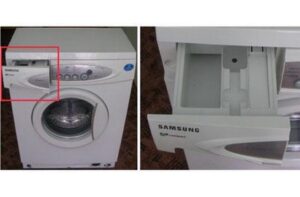 The tightness of the washing machine is the key to its safe operation. If a “trickle” flows down the body, then a leak has occurred and immediate repairs are required. Otherwise, a flood, short circuit and even “fatal outcome” of the equipment are possible. Usually, smudges on the front panel indicate that the powder bin of the washing machine is leaking. This is unpleasant, but can be easily fixed at home without calling for service.
The tightness of the washing machine is the key to its safe operation. If a “trickle” flows down the body, then a leak has occurred and immediate repairs are required. Otherwise, a flood, short circuit and even “fatal outcome” of the equipment are possible. Usually, smudges on the front panel indicate that the powder bin of the washing machine is leaking. This is unpleasant, but can be easily fixed at home without calling for service.
Troubleshooting
Before you think about what to do with the stream, you need to determine the cause of the leak. Only by knowing the location and scale of the breakdown can you completely eliminate the leak and prevent its recurrence. As a rule, new machines leak due to manufacturing defects, while old ones leak due to wear and tear of components.
If the machine was purchased recently, then independent repairs are prohibited - you should contact the service and take advantage of the warranty. You can deal with leaks on an old machine on your own. First of all, we determine where the tightness is broken: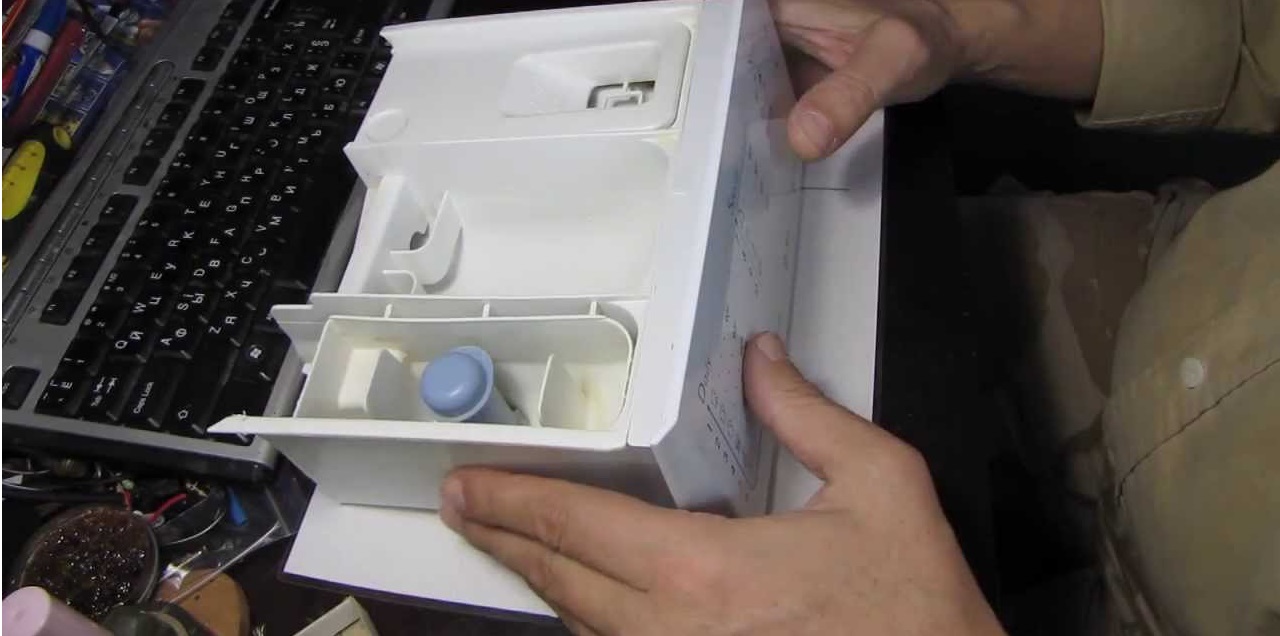
- along the perimeter of the powder receptacle, on the top or bottom side of the body;
- at the junction of the tray with the front of the washing machine;
- through the hole at the end (this means that one of the powder receiver compartments is damaged);
- through a loose or torn pipe (usually the fixing clamp weakens, the rubber comes off, and water leaks).
The powder receiver leaks water due to manufacturing defects, wear of components and careless operation.
Often the cause of a hopper leak is user carelessness. Often, when cleaning the powder receptacle, the owner of the washing machine begins to rush and tug at the part.As a result, the dispenser body or adjacent elements break, pipes come off or cracks occur. Active use of detergents with an aggressive composition can also lead to leakage: abrasive components “corrode” plastic and rubber, breaking the tightness of parts.
What is needed for a successful renovation?
Having found out why the dispenser is leaking, we begin to repair it. To stop the leak, you will need a certain set of tools. So, you should prepare:
- screwdrivers (phillips and slotted);
- pliers;
- file;
- hacksaw for metal.
The materials you will need are reliable silicone sealant. If the bin is very clogged, you will need cleaning agents - citric acid and laundry soap. Sometimes the powder receptacle is so damaged that the only solution is to replace it. In such a situation, a new tray is purchased, however, you first need to make sure that the old one is “dead”.
Description of repair
You cannot ignore the streams on the washing machine when filling with water. If you notice any leaks, you should forcefully stop the program you started, drain the water from the tank and try to determine the source of the “flood”. If there are no obvious reasons for a leak, we proceed to diagnostics. You will have to check all possible causes and fix the problem.
The first step is to open the powder receptacle, clamp the special lever in the central cuvette and remove the dispenser from the “socket”. Secondly, we inspect the bunker body, trying to find cracks, chips and other signs of broken seals. We also evaluate the contamination of the part: a thick layer of scale and detergent often leads to leakage. The explanation is simple: the collected water does not have time to pour into the drum, the compartments overflow, and the liquid spills out.
Are there any visible reasons, blockages or cracks? Then we begin an extended check. First, use a Phillips screwdriver to loosen the screws that secure the powder receptacle, and then remove the top cover of the machine. The next step is to find and inspect the four pipes connected to the bunker:
- the first and second are connected to the back of the dispenser and are necessary for drawing water;
- the third is reserved for air conditioning and is fixed against the right wall;
- the fourth is the thick corrugation on the left, adjacent to the counterweights.

The found pipes are disconnected from the hopper and, together with the tray itself, are taken out. As soon as all components are dismantled, the actual repair begins. The first step will be to clean the elements from scale and blockages.
The powder receptacle must be cleaned regularly to remove scale and powder!
It is not recommended to neglect the thorough cleaning of the powder receiver. It's not always a matter of a thick layer of plaque. Often small lime deposits and some hardened detergent residues clog the water supply nozzles. As a result, the liquid does not enter the tray in a smooth vertical stream, but chaotically - splashing onto the front wall of the hopper and landing on the end of the washer. It is better to immediately eliminate the blockage by soaking the part in a warm lemon solution at the rate of 50 g of acid per liter.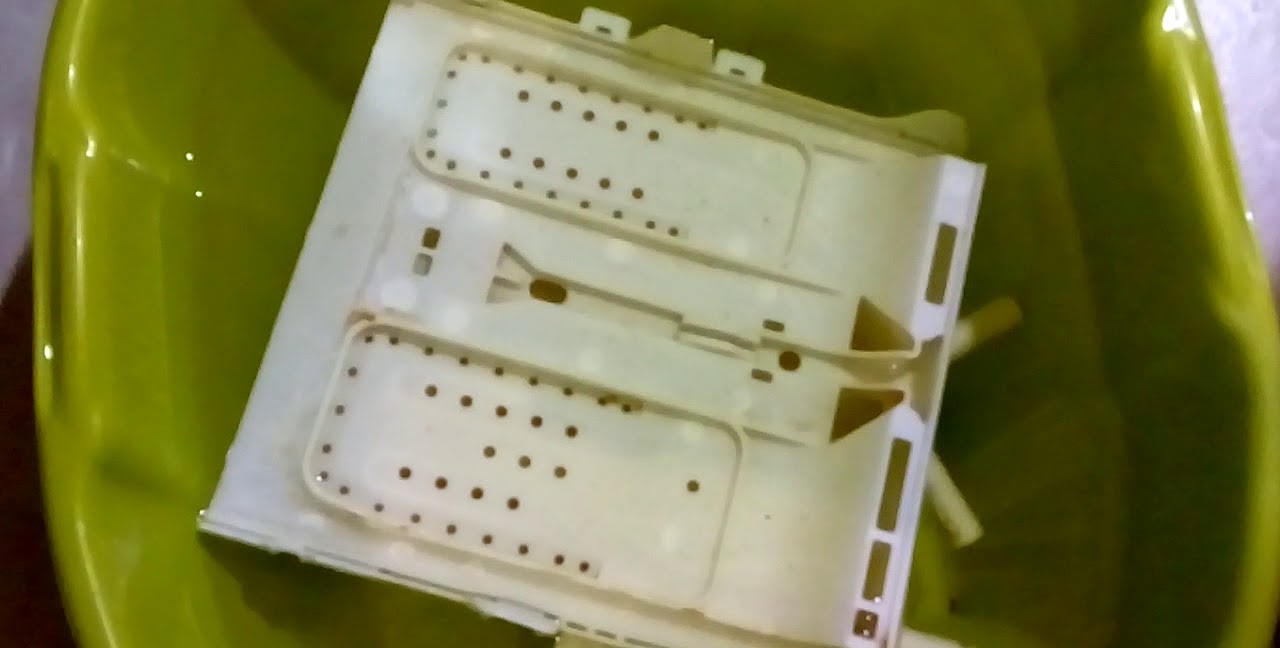
Next, we evaluate the condition of the fourth pipe:
- inspect the corrugation (due to its close proximity to the counterweight, it quickly wears out and loses its tightness);
- Having noticed damage to the rubber, we purchase a new pipe (patches are unreliable, it’s better not to risk it and buy a similar hose);
- “we are working on mistakes” (to prevent the situation from repeating, we seal the edge of the counterweight with polyethylene);
- fill the joint area with sealant;
- Apply sealant to all joints of the dispenser (use a flat screwdriver to press out the latches and fill the seams with glue).
Be sure to check the integrity of the remaining pipes of the powder receiver. If cracks are noticed, we change the hoses without trying to patch the holes with electrical tape. Replacement is also indicated if the bunker itself is damaged. Made? Then the machine is assembled in the reverse order and run for a test wash. If the leak occurs again, contact service.
Interesting:
Reader comments
- Share your opinion - leave a comment
Categories
Washing machine repair


For buyers

For users

Dishwasher


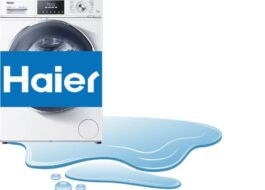

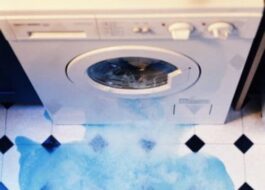
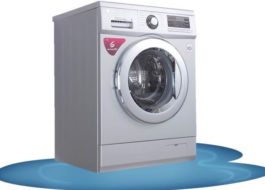
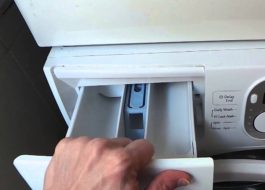










Add a comment